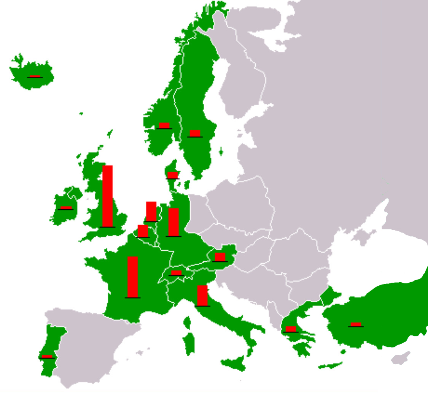Facts for Kids
The Cold War was a time of rivalry between the United States and the Soviet Union from 1947 to 1991, marked by competition over ideologies and nuclear weapons without direct fighting.
Overview
Nuclear Arms Race
End Of The Cold War
Key Events And Crises
Origins Of The Cold War
Post Cold War Consequences
Major Players And Ideologies
Cultural Impact And Propaganda
Proxy Wars And Global Influence
Legacy And Historical Interpretation

Inside this Article
Cuban Missile Crisis
Mikhail Gorbachev
Space Exploration
John F. Kennedy
Truman Doctrine
United States
Yuri Gagarin
North Korea
Kazakhstan
People
Did you know?
🇺🇸 The Cold War was a time of tension between the United States and the Soviet Union.
🌍 It started in 1947 after World War II and lasted until 1991!
💣 The Soviet Union developed nuclear bombs in 1949, increasing tensions.
🚧 One key event was the Berlin Blockade in 1948, when the Soviet Union blocked access to West Berlin.
📦 The US responded to the blockade with the Berlin Airlift to deliver supplies.
🚀 Both the US and the Soviet Union built many nuclear weapons during the Nuclear Arms Race.
🌿 Proxy wars were common, with the US and Soviet Union supporting different sides in conflicts like the Vietnam War.
🎸 The United States promoted rock 'n' roll and films as part of its culture during the Cold War.
🌉 The Berlin Wall was torn down in 1989, symbolizing the end of Cold War tensions.
🎉 The Cold War officially ended in 1991 when the Soviet Union dissolved.
Introduction
Nuclear Arms Race
This was known as the Nuclear Arms Race. The idea was to scare the other side, so they wouldn't attack. By the 1960s, the US had around 31,000 nuclear weapons, and the Soviet Union had thousands as well! They were like a giant game of "who has more?" 😮 The fear of a nuclear war was very real, and it kept both sides on high alert. People worried about what could happen if someone pressed the button, so they tried to find ways to talk instead of fight!
End Of The Cold War
The Soviet Union officially dissolved in 1991, leading to the end of the Cold War. People celebrated as the world took steps toward peace and cooperation, moving away from the divisions that had lasted for so many years! 🎉
Key Events And Crises
Origins Of The Cold War
Post-cold War Consequences
Countries like Ukraine and Kazakhstan gained independence. People in Eastern Europe began to experience more freedoms, and many adopted democratic forms of government. The United States emerged as the strongest superpower, while new challenges arose, including terrorism and conflicts in former Soviet regions. The end of the Cold War transformed international politics, leading to new alliances and changes in how countries interacted with one another. 🌏
Major Players And Ideologies
Cultural Impact And Propaganda
The Space Race was also exciting, as the US and the Soviet Union competed to send people to space. In 1961, Soviet cosmonaut Yuri Gagarin became the first human in space! 🌌
This competition for dominance seeped into the everyday lives of people all around the world!
Proxy Wars And Global Influence
Another example is the Korean War (1950-1953), which involved North Korea, backed by the Soviets, and South Korea, supported by the US and UN forces. These conflicts spread Cold War tensions around the world, showing how both superpowers tried to influence other nations and gain allies in the global game. 🌐
Legacy And Historical Interpretation
History books show how fear and competing ideologies shaped many countries' paths. The Cold War inspired many films, books, and even video games, making it an interesting topic for people to study! 🎮
Some argue that it brought innovation, like advancements in technology and space exploration. Understanding the Cold War helps us learn how the past continues to influence the present, reminding us that peace and cooperation are vital in our global community! 🌈

